The Entwined Serpents of Neak Poan In Angkor To Explore In 2025

Angkor civilization in Cambodia is one of those places lost in time that every individual needs to visit at least once in their lifetime to witness the beauty of the architecture and design. Among the elements of the archaeological complex, one place that stands out is Neak Poan, which is an artificial island with a Hindu temple built in the centre. Neak Poan, unlike its counterparts, is steeped in a lot of rich culture, heritage and history. However, what brings together the place’s significance up in the top is the existence of the small Hindu temple. If you are considering exploring Angkor, including Neak Poan in your must-visit spots lets you explore some of the underrated wonders of Angkor.
About Neak Poan
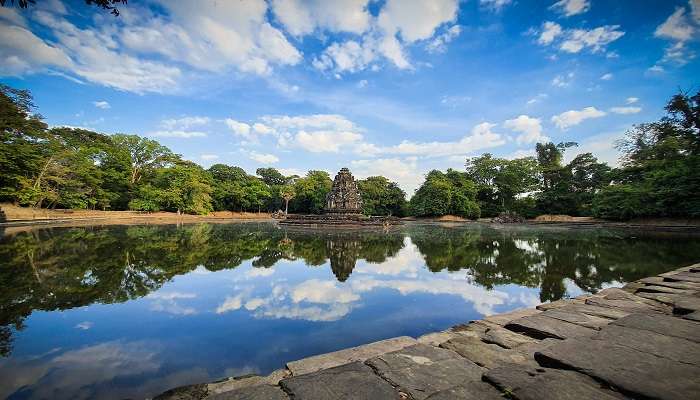
Neak Poan translates to the phrase “The Entwined Serpents” in Khmer and is a city in Angkor that dates back to 1191. It was built by the then ruler of the Khmer dynasty, Jayavarman VII as a dedication to Mahayana Buddhism. More than the significance of the secluded city, Neak Poan is primarily known for its secluded Hindu temple, which draws inspiration from the intricate architecture of the 12th century. It is perched amid the island of Jayatataka Baray, a vast dried-up reservoir. While the restored remnants of the temple remain in its original spot, Neak Poan is one of those historical places in the Angkorian complex where you get a glimpse into the true intricacies and precision of the Angkorian architectural style, etched onto the walls of the temple.
The name of this temple derives from the existence of the two intertwined serpents that lie in the central complex of the temple. Beyond the standard historical significance, its location in Jayataka, part of the extensive hydraulic network of the Khmer Empire, also plays a significant role in its existence. When it comes to the structure of the complex, it starts with the central sanctuary, surrounded by the circular island. There are four ponds in the perimeter of the temple as well. Some rumours depict that the design of the Neak Poan and its surrounding design represents the mythical Himalayan lake of Anavatapta, known for its healing properties.
Must Read: Silk Island Phnom Penh
Neak Poan History
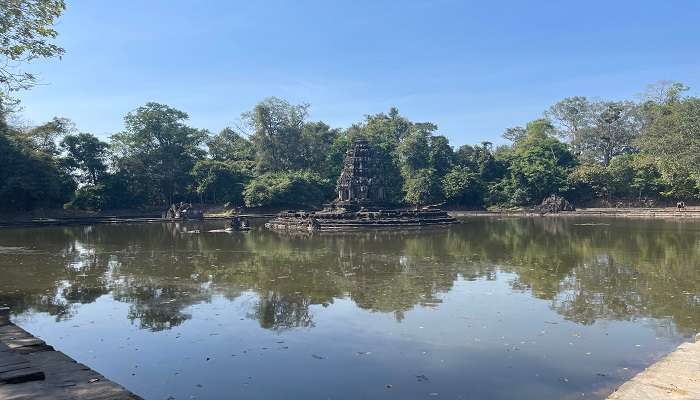
The Neak Poan History dates back to the 12th century, during the existence of the Khmer dynasty. It was constructed by King Jayavarman VII, who was one of the most renowned leaders of his time. Surprisingly, being a devout devotee of Buddhism, the King built the temple with one motive – To cure the people’s illness with the holy water from the surrounding ponds. With the central structure surrounded by four ponds, legends depict that the structure was designed to represent the four elements – water, earth, fire and air. What’s even more surprising is the direction in which each of these ponds is targeted. Each one of them is pointed towards a different direction.
The temple was part of a grander vision of Jayavarman VII, who constructed numerous temples, roads, and hospitals across his empire to improve the well-being of his people. However, with the downfall and slowing down of the Angkor empire, the maintenance of the Neak Poan temple took a backseat, which heavily contributed to its damage and destruction. It wouldn’t be until the 20th century that the restoration efforts would be in full swing, in an attempt to restore the bits of what was left of the original structure.
Neak Poan Architecture
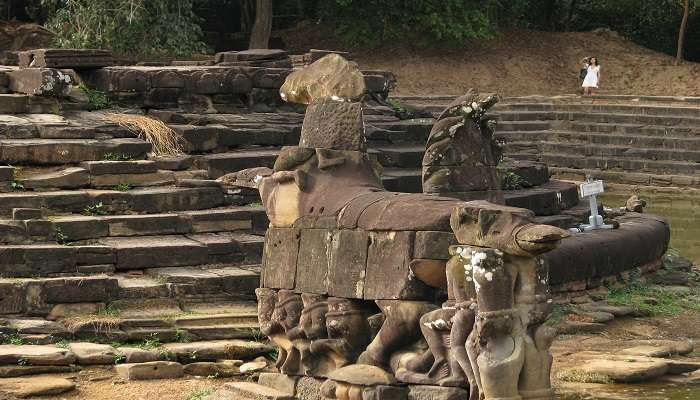
Beyond the elements of historical significance, Neak Poan architecture has caught people’s attention for years now. The combination of notable figures, unique design elements and symbolic elements further contribute to its significance. The layout and design of this complex have a blend of religious and practical intentions, which further cement its significance. The heart of Neak Poan is the central sanctuary, situated on a circular island at the centre of a large square reservoir called Jayatataka. This sanctuary is relatively small compared to other temples in Angkor, yet it is richly decorated and intricately carved. Like most of the buildings, temples and structures in the Angkor Archaeological Complex, even Neak Poan is built using sandstone and showcases the craftsmanship of the people. The walls of the complex also feature representations of Buddhist deities, apsaras (celestial dancers), and floral motifs.
Another crucial part of the Neak Poan temple worth exploring is the ponds. Four small ponds are aligned in cardinal directions and were believed to have medicinal properties in them. Lastly, the pathway leading up to the entrance of the temple features a long wooden causeway, crossing through the Jayatataka reservoir. There are stone bridges that line through the perimeter of the causeway, further adding structure and architectural relevance to the place.
Suggested Read: Ssowath Riverside Park
Things To Do At Neak Poan
Neak Poan Island is a fairly underrated part of the Angkor complex that many tourists miss out on. However, despite its small size, the place entrances its visitors with various activities, including:
1. Explore The Central Sanctuary
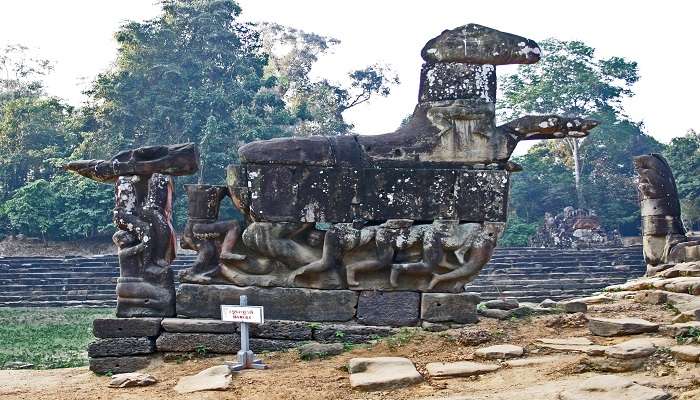
Among all the individual elements inside the island and the temple, the main attraction lies in the Central Sanctuary. The central tower is where the serpents exist, creating a marvellous structure with intricate detailing and design that reflects in the four surrounding ponds. You need to explore the temple during that time to be able to witness it.
2. Walk Through The Wooden Causeway
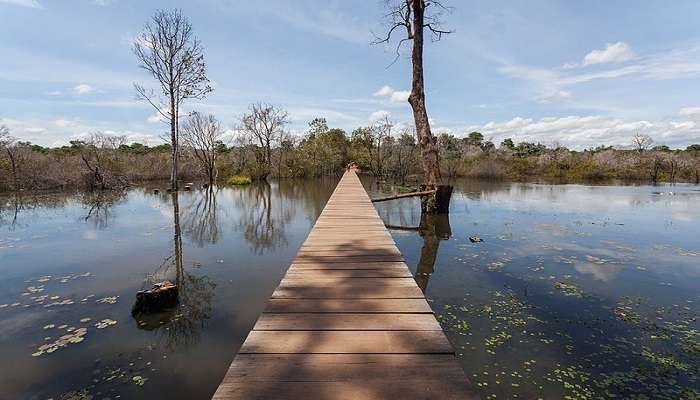
Beyond the design and architecture of the Neak Poan, the long wooden causeway leading up to the entrance of the Neak Poan is also quite an alluring experience. Getting to view the stunning views of the water and temple together is a worthwhile experience to explore.
Suggested Read: Prasat Ta Keo
3. Soak In The Intricate Designs And Architecture
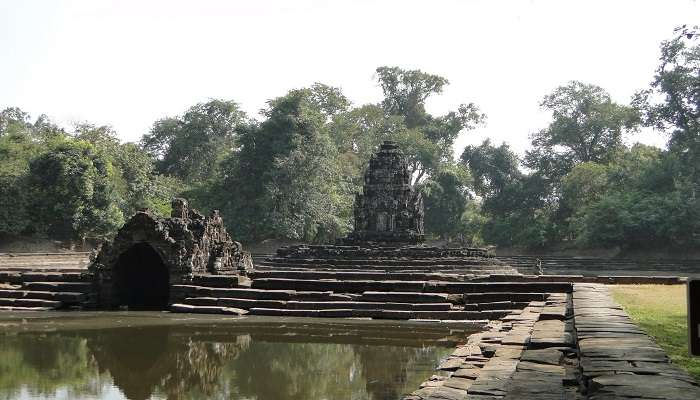
Not just the sculptures with religious significance, the insides of the temple also feature intricate designs of several animals, including elephants, lions and horses as well. Getting to sit around and scope out the peaceful surroundings is an experience in itself. Compared to the more crowded spots in the Angkor Archaeological Complex, this one offers a peaceful retreat option.
4. Explore The Nearby Structures And Complexes

Since the Neak Poan Cambodia is located inside the Angkor Archaeological Complex, you must make the most out of the occasion. The nearby complexes including Angkor Tham, Angkor Wat, Banteay Srei, etc. are some of the must-visit places around.
Suggested Read: Ta Prohm Temple
Neak Poan Temple Timings and Entry Fees
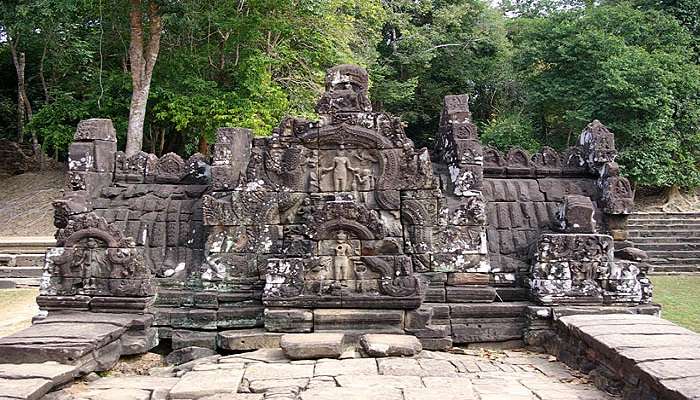
Neak Poan temple timings for visitors are from 07:30 AM to 05:30 PM. As for the Neak Poan entry fees, you need to purchase the Angkor Complex pass once you reach Siem Reap. The passes are available for a single day, three days or a week starting at $37.
To be able to witness the temple complex and the nearby ponds in their full glory, prioritise visiting during the daytime and wait until sunset for the views as well.
Best Time To Visit Neak Poan
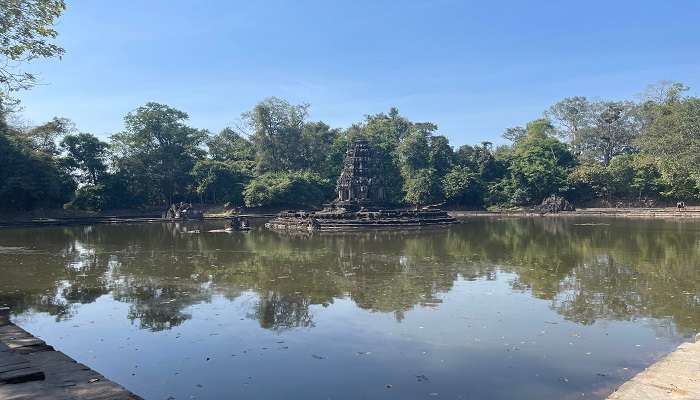
The months between November and April account for the peak season in Siem Reap. This is usually the time when most people prefer visiting, thanks to the comfortable weather conditions and clear skies, which make it easier for you to explore the grounds of the Angkor archaeological complex with ease. Keep in consideration that peak tourist season in Siem Reap can be overwhelming, especially if you don’t plan the specifics of your trip ahead of time.
Suggested Read: Pub Street
How To Reach

Neak Poan Cambodia is located inside the Angkor Archaeological Complex. The exact location of it is roughly 3 km from Angkor Wat.
So, once you are near Angkor Wat, you can either walk, take a tuk-tuk or rework or hire a taxi to take you to Neak Poan. Either way, transportation mediums are abundant, so you shouldn’t have any issues getting around.
Further Read: Pre Rup Temple
Neak Poan is one of the most significant temple complexes that depict the influence and the downfall of the Khmer Empire. With unique architecture and spiritual significance, the temple complex provides a glimpse into the tale of the past Angkorian culture. Ready to teleport back in history? Pack your bags and book your tickets for your trip to Cambodia to explore the beauty of Neak Poan and its historical influence.
For our editorial codes of conduct and copyright disclaimer, please click here.
Cover Image Credit: Mao Piseth for Wikimedia Commons
Frequently Asked Questions About Neak Poan
How much does it cost to go to Neak Pean?
There are no separate Neak Poan entry fees. You’d need to buy the Angkor Pass to be able to explore the temple and the island it stands on.
How much time does it take to explore Neak Poan Temple Cambodia?
Exploring the entire temple and island of Neak Poan usually takes between 40-60 minutes, depending on your pace.
What was the significance of the Neak Poan Temple in Cambodia?
The existence of Neak Poan Siem Reap takes us back to the days of the Angkor rulers when it was built as a centre of healing and cure for the people.
Which temples are near Neak Poan?
Neak Poan is surrounded by several unique temples in the Angkor Complex including Preah Khan, Ta Som, East Mebon, Angkor Thom, and Ta Prohm.
Are there dress code restrictions for visiting Neak Poan Island?
There aren’t any strict dress code restrictions for exploring Neak Poan island besides the fact that you should dress modestly.
People Also Read:
Places To Visit In Cambodia Things To Do In Cambodia 4 Days In Cambodia

Unveil the hidden treasures of the globe and turn every travel dream into reality. As a Content Writer, I am passionate enough to craft stories from ancient wonders to modern marvels. My words paint the picture-perfect itinerary for unforgettable experiences. Let my words be your trusted guide to immerse in the diverse culture and discover the beauty of the unknown.











